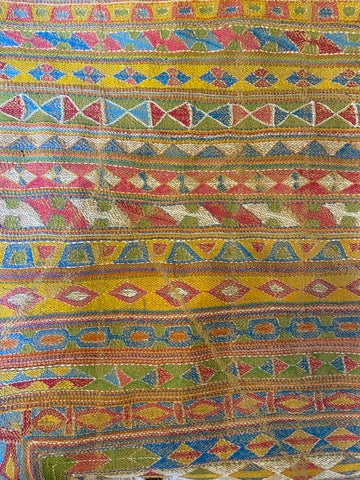We always get very excited about new deliveries of our Kanthas and really love seeing where they end up. In our hope to become more sustainable there is something rather satisfying about knowing that we are helping to re-purpose something that has already been re-purposed!
Kantha is one of the oldest forms of embroidery originating from India. "Kantha" refers to both the style of running stitch, as well as the finished cloth. The word kantha is believed to have been derived from the word "kontha" which means rags.

Having started in the villages of Bengal the art of Kantha nearly disappeared in the early 19th century before being revived in the 1940s. It was a craft that was practiced by women of all rural classes, and passed down through generations from mother to daughter. Sometimes grandmother, mother and daughter would work on the same kantha and it could take months or even years to complete.
Every family in Bengal would have a number of kanthas, they came in very handy as bedspreads for the winters and monsoon seasons. They were also used to swaddle babies. Expectant mothers might spend the last months of their pregnancy stitching a kantha, it was thought that it might protect the baby from disease and bring good fortune to the family.
Traditionally kantha blankets were made from saris, dhotis and lungis that were no longer able to be worn. These garments had become softened through wear and washing and the colours sometimes slightly faded too. The threads from the sari borders were removed and saved. Usually about five to seven fabrics would be layered together and then a neat running stitch was used to cover the whole cloth and provide strength. The stitching on the cloth gives a slightly wrinkled effect. Sometimes the stitch forms in abstract swirls or geometric designs, the original saved thread from the sari used to make intricate patterns. It could be very skilled work and all stitched freehand. If there were any holes these would be patched with scraps of fabric in other colours or patterns which adds great charm to the blanket. You won’t ever find a pair of Kanthas, they are all individual.
Modern day kanthas are often made using quite large stitches - we spend a long time searching for really good quality old kanthas which show off tiny, neat stitches. As you can see here.


An example of some of these designs is a small, rectangular bedspread, pictured above, in the V&A’s collection. It has beautiful but relatively simple embroidered flowers, spirals and paisley motifs.
Different types of Kantha quilts can be found depending on the region they were made. Ralli quilts originate from Sindh and Baluchistan in Pakistan and are distinguished by a series of geometric designs. These quilts are quite rare now so we were really thrilled when we found this one to add to our collection. Here you can see a close up of each side - one showing the vibrant, strong colours and the other, the more faded, soft colours where it has been exposed to the outside air.


Kanthas have many uses today and you can never have too many! Not only do they make fantastic bedspreads or throws they are also perfect picnic blankets or wall hangings. They can be used in upholstery too like the sofa we recovered below.

We also have a selection of cushions, laptop covers, washbags and hot water bottles all made out of our beautiful kanthas. Also - coats and bags. They can be made into curtains and headboards too, the options are nearly endless!
The stories these quilts tell of the women who made them bring a richness and quality to an interior which is hard to match. We love their vibrant colours and unique artistry and we hope you do too!
